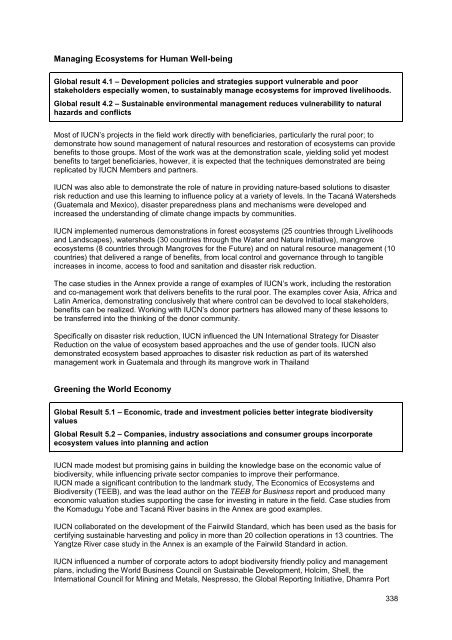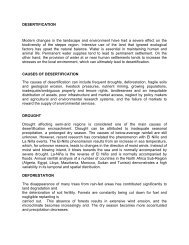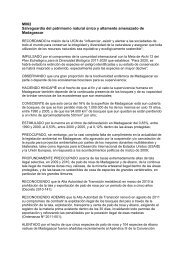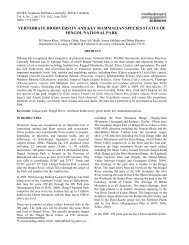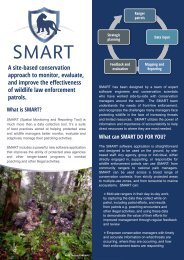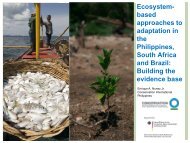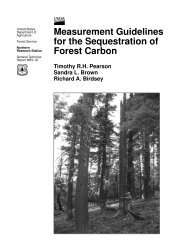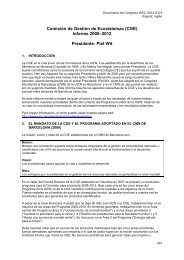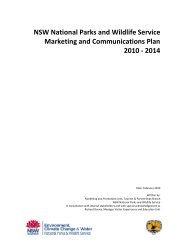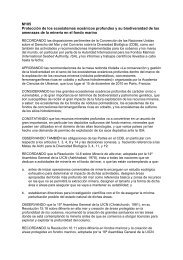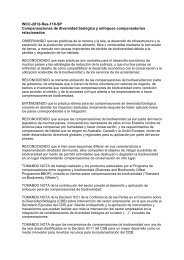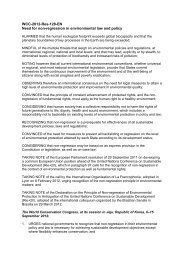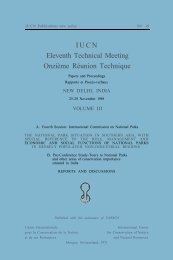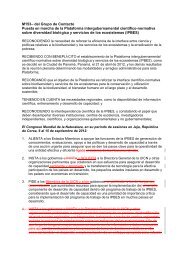Create successful ePaper yourself
Turn your PDF publications into a flip-book with our unique Google optimized e-Paper software.
Managing Ecosystems for Human Well-beingGlobal result 4.1 – Development policies and strategies support vulnerable and poorstakehol<strong>de</strong>rs especially women, to sustainably manage ecosystems for improved livelihoods.Global result 4.2 – Sustainable environmental management reduces vulnerability to naturalhazards and conflictsMost of <strong>IUCN</strong>’s projects in the field work directly with beneficiaries, particu<strong>la</strong>rly the rural poor; to<strong>de</strong>monstrate how sound management of natural resources and restoration of ecosystems can provi<strong>de</strong>benefits to those groups. Most of the work was at the <strong>de</strong>monstration scale, yielding solid yet mo<strong>de</strong>stbenefits to target beneficiaries, however, it is expected that the techniques <strong>de</strong>monstrated are beingreplicated by <strong>IUCN</strong> Members and partners.<strong>IUCN</strong> was also able to <strong>de</strong>monstrate the role of nature in providing nature-based solutions to disasterrisk reduction and use this learning to influence policy at a variety of levels. In the Tacaná Watersheds(Guatema<strong>la</strong> and Mexico), disaster preparedness p<strong>la</strong>ns and mechanisms were <strong>de</strong>veloped andincreased the un<strong>de</strong>rstanding of climate change impacts by communities.<strong>IUCN</strong> implemented numerous <strong>de</strong>monstrations in forest ecosystems (25 countries through Livelihoodsand Landscapes), watersheds (30 countries through the Water and Nature Initiative), mangroveecosystems (8 countries through Mangroves for the Future) and on natural resource management (10countries) that <strong>de</strong>livered a range of benefits, from local control and governance through to tangibleincreases in income, access to food and sanitation and disaster risk reduction.The case studies in the Annex provi<strong>de</strong> a range of examples of <strong>IUCN</strong>’s work, including the restorationand co-management work that <strong>de</strong>livers benefits to the rural poor. The examples cover Asia, Africa andLatin America, <strong>de</strong>monstrating conclusively that where control can be <strong>de</strong>volved to local stakehol<strong>de</strong>rs,benefits can be realized. Working with <strong>IUCN</strong>’s donor partners has allowed many of these lessons tobe transferred into the thinking of the donor community.Specifically on disaster risk reduction, <strong>IUCN</strong> influenced the UN International Strategy for DisasterReduction on the value of ecosystem based approaches and the use of gen<strong>de</strong>r tools. <strong>IUCN</strong> also<strong>de</strong>monstrated ecosystem based approaches to disaster risk reduction as part of its watershedmanagement work in Guatema<strong>la</strong> and through its mangrove work in Thai<strong>la</strong>ndGreening the World EconomyGlobal Result 5.1 – Economic, tra<strong>de</strong> and investment policies better integrate biodiversityvaluesGlobal Result 5.2 – Companies, industry associations and consumer groups incorporateecosystem values into p<strong>la</strong>nning and action<strong>IUCN</strong> ma<strong>de</strong> mo<strong>de</strong>st but promising gains in building the knowledge base on the economic value ofbiodiversity, while influencing private sector companies to improve their performance.<strong>IUCN</strong> ma<strong>de</strong> a significant contribution to the <strong>la</strong>ndmark study, The Economics of Ecosystems andBiodiversity (TEEB), and was the lead author on the TEEB for Business report and produced manyeconomic valuation studies supporting the case for investing in nature in the field. Case studies fromthe Komadugu Yobe and Tacaná River basins in the Annex are good examples.<strong>IUCN</strong> col<strong>la</strong>borated on the <strong>de</strong>velopment of the Fairwild Standard, which has been used as the basis forcertifying sustainable harvesting and policy in more than 20 collection operations in 13 countries. TheYangtze River case study in the Annex is an example of the Fairwild Standard in action.<strong>IUCN</strong> influenced a number of corporate actors to adopt biodiversity friendly policy and managementp<strong>la</strong>ns, including the World Business Council on Sustainable Development, Holcim, Shell, theInternational Council for Mining and Metals, Nespresso, the Global Reporting Initiative, Dhamra Port338


